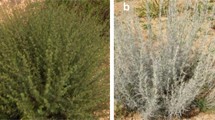Abstract
The leaves of Salvia officinalis and rhizomes of Zingiber officinalis, traditional Algerian medicinal plants, were analyzed by instrumental neutron activation analysis. The mass fractions of Fe (940, 1176 µg/g), Mn (LLD, 0.716 mg/g), Na (0.58, 0.28 mg/g), K (19, 23 mg/g), Cl (1.8, 0.59 mg/g), Zn (16.4, 55.6 µg/g) and Eu (LLD, 0.31 µg/g) were determined in Zingiber officinalis and Salvia officinalis respectively. The essential elements found in these plants may confer some of their beneficial properties, but the high level of Eu, potential toxic element found in the sage leaves, may require further investigation.



Similar content being viewed by others
References
Steiner (ed.) R P (1986) Folk medicine—the art and the science. American Chemical Society, Washington DC, p 223
WHO-World Health Organization (1996) Annex II. Guidelines for the Assessment of Herbal Medicines (WHO Technical Report Series NO. 863) Geneva
WHO-World Health Organization (2008) Traditional medicine fact sheet, Number 134
British Medical Association (1993) Complementary medicine, new approaches to good practice. Oxford University Press, Oxford
WHO (2002b) Traditional medicine strategy (2002–2005). WHO/EDM/TRM/2002.1. Geneva, Switzerland
Cosyns JP, Jadoul M, Squifflet JP, Wese FX, Ypersele Van, de Strihou C (1999) Urothelial lesions in Chinese-herb nephropathy. Am J Kidney Dis 33:1011–1017. doi:10.1016/S0272-6386(99)70136-8
Ernst E (2002) Toxic heavy metals and undeclared drugs in Asian herbal medicines. Trends Pharmacol Sci 23:136–139. doi:10.1016/S0165-6147(00)01972-6
Tomori WJ, Obijole OA (2000) Mineral composition of some less utilized vegetables in Nigeria. Afr J Sci Technol 1(12):153–157
Paranjpe P (2001) Indian medicinal plants, forgotten healers, a guide to ayurvedic herbal medicine. Chaukhamba Sanskrit Pratisthan, Delhi, p 316
Sivarajan VV, Balachandran I (1994) Ayurvedic drugs and their plant sources. Oxford & IBH Publishing Co. Pvt. Ltd, New Delhi, p 570
Rajurkar NS, Damame MM (1998) Mineral content of medicinal plants used in treatment of diseases resulting from urinary tract disorders. Appl Radiat Isot 49:773
Kimura K (1996) Role of essential trace elements in the disturbance of carbohydrate metabolism. Nippon Rinsho 54(1):79–84
Underwood EJ (1977) Trace elements in human and animal nutrition, 4th edn. Academic Press, New York, p 255
El Yzigi A, Hannan N, Raines DA (1991) Urinary excretion of chromium, copper and manganese in diabetes mellitus and associated disorders. Diabetes Res 18:129–134
Johri RK, Zutshi U (1992) An ayurvedic formulation of Trikatu and its constituents. J Ethnopharmacol 37:85
Funtua II, Dim LA, Muazu S, Oyewale AO, Umar IM, Grass F, Gwozdz R (2003) Instrumental neutron activation analysis (INAA) of Guierasenegalensis (Combrataceae)—a tropical medicinal plant. Nig J Phys 9(15):105
Bode P (1996) Instrumental and organization aspects of a neutron activation analysis laboratory. Delft University of Technology, p 148
Paul Choudhury R, Kumar A, Reddy AVR, Garg AN (2006) Thermal neutron activation analysis of essential and trace elements and organic constituents in Trikatu : ayurvedic formulation. J Radioanal Nucl Chem. doi:10.1007/s10967-007-1130-0
Bielicka–Gieldon A, Rylko E (2013) Estimation of metallic in herbs and spices available on the polish market. Pol J Environ Stud 22(4):1251–1256
Rajurkar NS, Pardeshi BM (1997) Analysis of some herbal plants from India used in the control of diabetes mellitus by NAA and AAS techniques. Appl Radiat Isot 48:1059
Rim KT, Koo KH, Park JS (2013) Toxicological evaluations of rare earths and their health impacts to workers, a literature review. Saf Health Work 4:12–26
Li Xuesong, Hristozova G, Nekhoroshkov PS, Frontasyeva MV (2015) Neutron activation analysis of constituent elements of edible and medicinal plant of iron stick yam (Dioscorea opposite Thunb). IRJPE-Health 2(11):182–190
Bonner FW, Bridjes JW, James W (1983) Toxicological properties of trace elements. In: Rose J (ed) Trace elements in health. Butterworth & Co, London, pp 1–16
Kratochvil B, Motkosky N (1986) Determination of trace aluminum concentration and homogeneity in biological reference material TORT-1 by instrumental neutron activation analysis and graphite furnace atomic absorption spectroscopy. Can J Chem 65:1047–1050
Toto RD, Hulter HN, Mackie S, Sebastian A (1984) Renal tubular acidosis induced by dietary chloride. Kidney Int 25:26
Sackmann B, Neher E (1984) Patch clamp techniques for studying ionic channels in excitable membranes. Annu Rev Physiol 46:455
Naga Raju GJ, Sarita P, Ramana Murty GAV, Ravi Kumar M, Seetharami Reddy B, John Charles M, Lakshminarayana S, Seshi Reddy T, Bhuloka Reddy S, Vijayan V (2006) Estimation of trace elements in some anti-diabetic medicinal plants using PIXE technique. Appl Radiat Isot 64:893–900
Reddy MB, Chidambaram MV, Bates GW (1987) In: Winkelmann G, van der Helm D, Neilands JB (eds) Iron transport in microbes, plants and animals. Wiley-VCH, New York, p 429
Van der Strate BW, Beljaars L, Molema G, Harmsen MC, Meijer DK (2001) Antiviral activities of lactoferrin. Antivir Res 52:225
Bhaskaram P (2002) Micronutrient malnutrition, infection, and immunity. Nutr Rev 60:S40
Korc M (1983) Manganese action on pancreatic protein synthesis in normal and diabetic rats. Am J Physiol 245:628–634
Devi NK, Sharma NH, Kumar S (2008) Estimation of essential and trace elements in some medicinal plants by PIXE and PIGE techniques. Nucl Instrum Methods Phys Res B 266:1605–1610
Reddy PRK, Reddy SJ (1997) Elemental mass fractions in medicinally important leafy materials. Chemosphere 34:2193–2212
Singh V, Garg AN (1997) Availability of essential trace elements in Ayurvedic Indian medicinal herbs using instrumental neutron activation analysis. Appl Radiat Isot 48:97
O’Dell BL, Sunde RA (1997) (eds.) Handbook of nutritionally essential mineral elements. Marcel Dekker Inc, New York
Sizer F, Whitney E (1999) Nutrition concepts and controversies, 8th edn. Wadsworth Publishing Company, Belmont
Lokhande R, Singare P, Andhele M, Acharya R (2010) Study of some Indian medicinal plants by application of INAA and AAS techniques. Nat Sci 2(1):26–32
Author information
Authors and Affiliations
Corresponding author
Rights and permissions
About this article
Cite this article
Lamari, Z., Larbi, R. & Negache, H. Trace element content of Zingiber officinalis and Salvia officinalis medicinal plants from Algeria. J Radioanal Nucl Chem 309, 17–22 (2016). https://doi.org/10.1007/s10967-016-4858-6
Received:
Published:
Issue Date:
DOI: https://doi.org/10.1007/s10967-016-4858-6




